基于亲和层析的两种蛋白质纯化策略
分离纯化蛋白质的方法
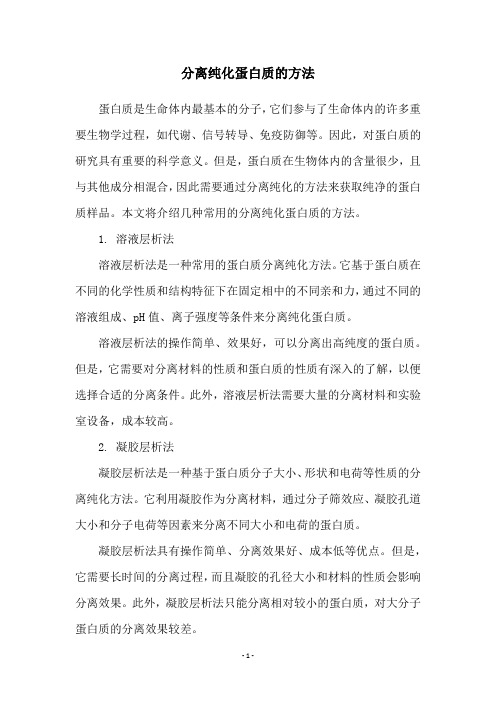
分离纯化蛋白质的方法蛋白质是生命体内最基本的分子,它们参与了生命体内的许多重要生物学过程,如代谢、信号转导、免疫防御等。
因此,对蛋白质的研究具有重要的科学意义。
但是,蛋白质在生物体内的含量很少,且与其他成分相混合,因此需要通过分离纯化的方法来获取纯净的蛋白质样品。
本文将介绍几种常用的分离纯化蛋白质的方法。
1. 溶液层析法溶液层析法是一种常用的蛋白质分离纯化方法。
它基于蛋白质在不同的化学性质和结构特征下在固定相中的不同亲和力,通过不同的溶液组成、pH值、离子强度等条件来分离纯化蛋白质。
溶液层析法的操作简单、效果好,可以分离出高纯度的蛋白质。
但是,它需要对分离材料的性质和蛋白质的性质有深入的了解,以便选择合适的分离条件。
此外,溶液层析法需要大量的分离材料和实验室设备,成本较高。
2. 凝胶层析法凝胶层析法是一种基于蛋白质分子大小、形状和电荷等性质的分离纯化方法。
它利用凝胶作为分离材料,通过分子筛效应、凝胶孔道大小和分子电荷等因素来分离不同大小和电荷的蛋白质。
凝胶层析法具有操作简单、分离效果好、成本低等优点。
但是,它需要长时间的分离过程,而且凝胶的孔径大小和材料的性质会影响分离效果。
此外,凝胶层析法只能分离相对较小的蛋白质,对大分子蛋白质的分离效果较差。
3. 电泳法电泳法是一种通过电场作用将不同电荷的蛋白质分离的方法。
它利用电泳移动速度与蛋白质质量和电荷密度之间的关系,将蛋白质分离纯化。
电泳法具有操作简单、分离效果好、成本低等优点。
但是,它需要专业的电泳设备和实验技能,而且对蛋白质的性质和电泳条件有较高的要求。
此外,电泳法只能分离相对较小的蛋白质,对大分子蛋白质的分离效果较差。
4. 亲和层析法亲和层析法是一种基于蛋白质与其配体之间的亲和作用来分离纯化蛋白质的方法。
它利用配体与蛋白质的特异性结合来分离纯化目标蛋白质。
亲和层析法具有分离效果好、选择性高、可重复使用等优点。
但是,它需要高纯度的配体和专业的实验技能,而且对蛋白质的性质和配体的选择有较高的要求。
四种蛋白纯化方法

四种蛋白纯化方法1. 溶液沉淀法溶液沉淀法是一种常用的蛋白纯化方法,适用于从复杂的混合物中分离目标蛋白。
该方法基于蛋白质在不同条件下的溶解度差异,通过添加盐类或有机溶剂来诱导蛋白质的沉淀。
步骤:1.样品制备:将待纯化的样品经过初步处理,如细胞破碎、组织切割等,得到含有目标蛋白的混合物。
2.溶解度测试:在不同条件下(如pH、温度、盐浓度等)测试目标蛋白质的溶解度,并确定最适合其沉淀的条件。
3.沉淀:根据前一步骤确定的最佳条件,向样品中添加盐类或有机溶剂,使目标蛋白质发生沉淀。
可以通过离心将沉淀物与上清液分离。
4.溶解:将沉淀物重新溶解在适当的缓冲液中,得到纯化后的目标蛋白。
优点:•简单易行,不需要复杂的设备和操作。
•适用于从复杂混合物中纯化目标蛋白。
缺点:•可能会导致非特异性沉淀,使得纯化后的蛋白含有杂质。
•沉淀方法对蛋白质的溶解度要求较高,不适用于所有蛋白。
2. 凝胶过滤法凝胶过滤法是一种基于分子大小的蛋白纯化方法,适用于分离不同分子量范围的蛋白。
该方法利用孔径可调的凝胶柱或膜来分离目标蛋白和其他小分子。
步骤:1.样品制备:将待纯化的样品经过初步处理,如细胞破碎、组织切割等,得到含有目标蛋白的混合物。
2.凝胶柱选择:根据目标蛋白的分子量范围选择合适孔径的凝胶柱或膜。
3.样品加载:将样品加载到凝胶柱上,并使用缓冲液进行洗涤,以去除小分子。
4.蛋白洗脱:通过改变缓冲液的组成或pH值,使目标蛋白从凝胶柱上洗脱下来。
5.收集纯化蛋白:将洗脱得到的蛋白收集起来,即可得到纯化后的目标蛋白。
优点:•可以根据分子量范围选择合适的凝胶柱,实现高效分离。
•纯化后的蛋白质纯度较高。
缺点:•操作相对复杂,需要一定的专业知识和技术。
•只适用于分子量差异较大的目标蛋白。
3. 亲和层析法亲和层析法是一种基于生物分子间特异性相互作用的蛋白纯化方法,适用于富含目标蛋白的混合物。
该方法利用目标蛋白与特定配体之间的亲和力进行分离和纯化。
蛋白质纯化的方法选择

蛋白质纯化的方法选择蛋白质纯化是一种将复杂的混合物中的目标蛋白质分离出来的过程,其目的是获得纯度较高的蛋白质样品,以便进行进一步的研究。
在蛋白质纯化过程中,选择适当的方法至关重要,以下是一些常用的蛋白质纯化方法及其特点:1.溶液沉淀法溶液沉淀法是最简单和最常用的蛋白质纯化方法之一、基本原理是通过改变蛋白质的溶解度,使其从溶液中沉淀出来。
常见的溶液沉淀剂有硫酸铵、磷酸铵和醋酸锌等。
这种方法适用于将目标蛋白质从复杂的混合物中富集出来,但无法获得高纯度的蛋白质样品。
2.离子交换层析法离子交换层析法利用离子交换树脂对蛋白质进行分离和纯化。
树脂中的功能基团能够与蛋白质的带电基团发生相互作用,吸附或释放蛋白质。
离子交换层析法适用于富集带相同电荷的蛋白质,但不能获得高纯度的蛋白质样品。
3.亲和层析法亲和层析法利用目标蛋白质与特定配体之间的特异性结合进行分离和纯化。
常见的亲和层析方法包括亲和层析柱和亲和标记技术。
亲和层析法能够选择性地富集目标蛋白质,并获得较高纯度的样品。
但该方法需要配体的特异性和标记的技术支持。
4.尺寸排阻层析法尺寸排阻层析法是一种按照蛋白质在柱子中通过的速度进行分离和纯化的方法。
根据蛋白质的尺寸大小选择不同的尺寸排阻柱,较大的蛋白质在柱子中通过的速度较快,较小的蛋白质在柱子中通过的速度较慢。
尺寸排阻层析法适用于富集目标蛋白质,并能获得较高纯度的样品。
5.电泳法电泳是一种将蛋白质根据其电荷和尺寸分离和纯化的方法。
常见的电泳方法包括SDS-、等电聚焦和二维凝胶电泳等。
电泳法可以获得高纯度的蛋白质样品,但对蛋白质稳定性和成本要求较高。
综上所述,蛋白质纯化方法的选择应根据目标蛋白质的特性和纯度要求决定。
在实际操作中,常常需要结合多种方法进行联合纯化,以获得更高纯度的蛋白质样品。
此外,还应根据实验室的设备和技术条件,选择适合的蛋白质纯化方法。
3种进行基因工程表达目的蛋白质的分离纯化方法

3种进行基因工程表达目的蛋白质的分离纯化方法在基因工程研究中,蛋白质分离纯化是非常重要的一环。
下面将介绍三种常用的基因工程表达目的蛋白质分离纯化方法。
1. 亲和层析法:亲和层析法是一种常用的蛋白质纯化方法,基于特定配体与目标蛋白质之间的选择性结合。
通常,可以在目标蛋白质中引入一个标签序列,如融合标签或标签标记,使其与固定在纯化层析柱上的配体相互作用。
配体可以是金属离子、抗体、亲和剂或其他具有与目标蛋白质选择性相互作用的分子。
利用这种亲和层析柱进行分离纯化时,可以通过洗脱缓冲液中高浓度的竞争性配体或特定的环境条件来实现目标蛋白质的高效纯化。
2. 凝胶电泳法:凝胶电泳法是一种常用的蛋白质分离技术,根据蛋白质在电场中的迁移速率差异进行分离纯化。
通常,首先将表达目的蛋白质从细胞裂解物或培养基中提取出来,并用浓缩技术进行初步富集。
然后,将蛋白质样品加载到凝胶(如SDS-PAGE凝胶)中,通过应用电场分离蛋白质。
根据蛋白质的大小和电荷来进行分离,并用染色或质谱等方法进行检测和分析。
3. 逆流层析法:逆流层析法是一种有效的分离纯化方法,根据蛋白质在逆流梯度中的亲和性差异进行分离。
该方法可通过将纯化柱分为若干区域,每个区域都包含不同浓度的缓冲液,从而形成逆流梯度。
蛋白质溶液经过逆流层析柱时,蛋白质会在不同条件下与纯化柱表面相互作用,并在梯度中发生多次吸附和洗脱过程。
通过逆流层析的多次循环,可以逐步富集并纯化目标蛋白质。
综上所述,亲和层析法、凝胶电泳法和逆流层析法是基因工程表达目的蛋白质常用的分离纯化方法。
这些方法各具优势,可以根据目标蛋白质的性质和实验要求选择适合的方法,以获得高纯度的表达目的蛋白质。
两步色谱纯化技术在蛋白质制备中的应用

两步色谱纯化技术在蛋白质制备中的应用蛋白质是生物体内重要的分子组成部分,对于研究生命活动、药物研发等具有重要意义。
在蛋白质的制备过程中,纯化是一个至关重要的步骤。
传统的蛋白质纯化方法常常耗时、低效,并且易出现损失。
然而,近年来发展起来的两步色谱纯化技术,改变了传统纯化方法的局限性,成为了一种重要的纯化手段。
两步色谱纯化技术结合了亲和层析和离子交换层析两种技术的优势,并通过两个步骤的有序操作,实现了对蛋白质的高效纯化。
接下来,本文将对两步色谱纯化技术的原理和应用进行详细介绍。
第一步是亲和层析纯化。
亲和层析是一种基于蛋白质和其结合物之间特异性相互作用的分离方法。
亲和层析可以通过蛋白质的特定性质选择性地与其他杂质分离开来。
常见的亲和层析介质包括亲和柱、亲和树脂等。
在亲和层析步骤中,我们可以利用蛋白质与特定配体之间的亲和性质,将目标蛋白质选择性地吸附到亲和层析介质上。
通过洗脱某些特殊配体的方式,我们可以将目标蛋白质从亲和层析介质上洗脱下来,实现目标蛋白质的纯化。
第二步是离子交换层析纯化。
离子交换层析是一种利用杂质与离子交换介质之间的电荷相互作用进行分离的方法。
离子交换层析具有选择性强、纯化效果好的优势。
在离子交换层析步骤中,我们可以根据蛋白质的电荷性质选择合适的离子交换介质,将目标蛋白质与其他带相反电荷的杂质分离开来。
通过改变离子交换介质中的溶液条件,例如改变pH值或离子浓度,可以控制目标蛋白质与介质之间的相互作用,实现目标蛋白质的纯化。
两步色谱纯化技术在蛋白质制备中的应用非常广泛。
首先,在研究领域,两步色谱纯化技术可以用于从复杂的细胞提取物中纯化目标蛋白质,从而便于后续的功能研究。
其次,在药物研发中,两步色谱纯化技术可以用于制备高纯度的药物靶蛋白,为药物研发提供优质的材料基础。
此外,两步色谱纯化技术还可以应用于生物技术工业中,用于制备高价值的重组蛋白质产品,满足市场需求。
总结起来,两步色谱纯化技术以其高效、可靠的特性,在蛋白质制备中得到广泛应用。
亲和层析法离纯化蛋白质的方法

亲和层析法离纯化蛋白质的方法亲和层析法是一种利用特定配体与目标蛋白质间的亲和作用来分离和纯化目标蛋白质的方法。
该方法简单、高效、选择性强,并且适用于分离和纯化各种规模和属性的蛋白质,因此被广泛应用于生物化学、分子生物学等领域。
亲和层析法的实验步骤如下:1. 配制亲和柱:将特定的配体化合物固定到柱载体上,例如:Ni2+、Protein A/G、抗体等。
固定过程要注意化合物与柱载体的适应性、配位化合物的浓度和固定条件的优化。
2. 样品制备:将待纯化蛋白质与适当的缓冲液混合,如含有余量目标蛋白质竞争配位位点的化合物、pH、离子强度和结构安定剂等。
3. 样品加载:将样品加入亲和柱顶部,让其通过固定的配体和柱内质子、离子等的相互作用与目标蛋白质结合。
样品通过后,用缓冲液淋洗一段时间以去除无关的物质,并测定逐步洗出的蛋白质含量。
4. 洗脱蛋白质:通过改变洗脱缓冲液的pH值,鸟嘌呤核苷酸、纳米微粒、配体等离子强度和竞争配位位点的化合物,剥离蛋白质与配体的相互作用,释放出目标蛋白质。
蛋白质最终会在柱底部被洗出,收集洗脱后的纯化蛋白质即可。
亲和层析法具有一些优点:1. 选择性强,可用于纯化特定蛋白质。
2. 纯化步骤简单,样品不需预备过多。
3. 取得的蛋白质纯度高。
4. 在蛋白质分子中较不会引起构象或孔洞变化,使分离后蛋白质结构相对完整。
1. 需要合适的配体化合物,且有些化合物不易制备或使用方便性较差。
2. 某些特殊的蛋白质可能无相应亲和层析柱,或需要进行配体修饰。
3. 无法分离某些蛋白质互作产物,因为这些产物与配体的亲和性可能相同或更好。
亲合层析原理及标签蛋白纯化
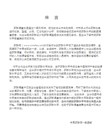
特异性
支链甘露糖, 终端甘露糖或葡萄糖 通过α(1,6) 糖苷键连接与海澡糖上 的N-乙酰基-葡萄糖胺的支链甘露糖
亲和层析柱和平衡
重点 • 柱体积:
– 依据目标物的数量和填料的载量确定,Hitrap 1ml and 5ml.
样品准备
重点 • 过滤或离心以去除颗粒性物质 • 用脱盐柱校正样品的pH、盐浓度和添加剂来 提高结合的效率 • 确保已知的能影响结合的物质不存在
• 柱高:
– 无严格要求,一般是短而粗
• 平衡:
– 无严格要求, 对于 HiTrap™柱可以用注射器平衡
上样
重点 • 按照标准程序作 • 上样前充分平衡柱子 • 结合缓冲液一般采用中性 pH • 确保平衡:
– 亲和作用较强或比较容易平衡: 高流速 – 亲和作用较弱或比较难平衡: 慢流速
Troubleshooting
为什么选择亲和层析?
offers high selectivity, hence high resolution, and usually high capacity for the protein(s) of interest • 亲和层析能够完成一般方法很难完成的分离
– 如变性和非变性的,功能不同的蛋白
任何规模纯化都比较简单-Ni Sepharose
预装柱/填料 一次可纯化组氨酸融合蛋 白的量 注意
•筛选参数更方便和可再生的优化;预 装柱,上未澄清样品;用机械手自动操 作或使用离心机/抽真空等手动方式操 作 简化流程:预装柱,上未澄清样品, 离心 预装柱,重力,上未澄清样品 可直接上未澄清的样品,同HisTrap 预装柱,可用注射器、蠕动泵,层析 系统,样品必须澄清 适合大规模样品纯化,简化流程:无 需装柱可用蠕动泵,层析系统操作 •不同包装的凝胶,需要自行装填,客 户需自备空柱 •可用蠕动泵,层析系统(如ÄKTA) 或者批量操作
蛋白质的纯化的方法及原理

蛋白质的纯化的方法及原理蛋白质的纯化是从其来源中去除其他有机物和无机物,使其成为纯净的蛋白质样品的过程。
蛋白质纯化的方法可以根据需要选择,其中常用的方法包括盐析、凝胶过滤、电泳、金属柱层析、亲和层析、离子交换层析、逆相高效液相色谱等。
下面将详细介绍这些方法及其原理。
一、盐析盐析是利用不同浓度的盐溶液对蛋白质溶液进行逐渐稀释,从而使蛋白质发生沉淀的过程。
纯化蛋白质的关键是利用蛋白质与溶剂中离子之间的相互作用来控制蛋白质的溶解和沉淀过程。
在盐析中,通过选择离子强度和种类可以调整蛋白质溶液中所需溶剂化离子的浓度,达到沉淀和纯化蛋白质的目的。
二、凝胶过滤凝胶过滤是一种分子筛分离方法,利用不同孔径的凝胶进行分离。
凝胶的孔径能够排除较大分子,如核酸和细胞碎片,而较小分子,如蛋白质则能通过孔隙,实现纯化。
该方法简单易行,不需要任何特殊设备,适用于中小分子量的蛋白质纯化。
三、电泳电泳是利用蛋白质在电场中的移动性差异进行分离和纯化的方法。
常用的电泳方法有平板电泳、SDS-PAGE(聚丙烯酰胺凝胶电泳)和Western blotting (免疫印迹法)等。
电泳能够根据蛋白质的电荷、分子大小和不同的电场力,在凝胶中分离蛋白质,使其形成带状。
通过切割所需蛋白质的带状区域,可以实现对目标蛋白质的纯化。
四、金属柱层析金属柱层析是利用金属离子与蛋白质之间的亲和性进行分离的方法。
金属柱通常被配制成金属离子亲和基质,并固定在柱子上。
目标蛋白质通过与金属离子发生亲和作用而被保留在柱中,其他杂质则从柱中流出。
通过调节洗脱缓冲液的离子浓度和pH值,可实现对目标蛋白质的纯化。
五、亲和层析亲和层析是利用配体与其特异性结合的蛋白质进行分离和纯化的方法。
通常将配体固定在柱子上,待蛋白质样品通过柱子时,目标蛋白质与配体结合,其他杂质则流失。
通过改变洗脱缓冲液的条件,如离子浓度、pH值和络合剂的添加,可以实现目标蛋白质的纯化。
六、离子交换层析离子交换层析是一种利用蛋白质与离子交换基质之间的相互作用进行分离和纯化的方法。
蛋白质纯化策略并举例
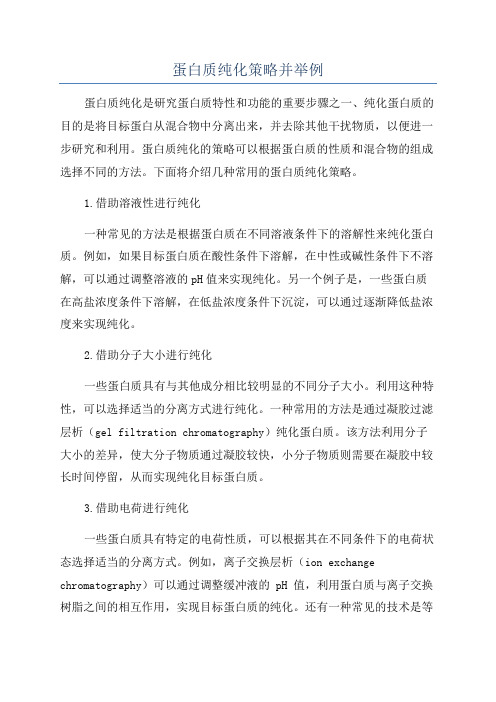
蛋白质纯化策略并举例蛋白质纯化是研究蛋白质特性和功能的重要步骤之一、纯化蛋白质的目的是将目标蛋白从混合物中分离出来,并去除其他干扰物质,以便进一步研究和利用。
蛋白质纯化的策略可以根据蛋白质的性质和混合物的组成选择不同的方法。
下面将介绍几种常用的蛋白质纯化策略。
1.借助溶液性进行纯化一种常见的方法是根据蛋白质在不同溶液条件下的溶解性来纯化蛋白质。
例如,如果目标蛋白质在酸性条件下溶解,在中性或碱性条件下不溶解,可以通过调整溶液的pH值来实现纯化。
另一个例子是,一些蛋白质在高盐浓度条件下溶解,在低盐浓度条件下沉淀,可以通过逐渐降低盐浓度来实现纯化。
2.借助分子大小进行纯化一些蛋白质具有与其他成分相比较明显的不同分子大小。
利用这种特性,可以选择适当的分离方式进行纯化。
一种常用的方法是通过凝胶过滤层析(gel filtration chromatography)纯化蛋白质。
该方法利用分子大小的差异,使大分子物质通过凝胶较快,小分子物质则需要在凝胶中较长时间停留,从而实现纯化目标蛋白质。
3.借助电荷进行纯化一些蛋白质具有特定的电荷性质,可以根据其在不同条件下的电荷状态选择适当的分离方式。
例如,离子交换层析(ion exchange chromatography)可以通过调整缓冲液的 pH 值,利用蛋白质与离子交换树脂之间的相互作用,实现目标蛋白质的纯化。
还有一种常见的技术是等电聚焦(isoelectric focusing),该方法是利用蛋白质在不同 pH 值下的等电点移动来实现纯化。
4.借助亲和性进行纯化5.借助活性进行纯化一些蛋白质具有特定的酶活性、配体结合性等活性,可以通过专一酶活性或配体结合性来进行纯化。
例如,利用蛋白质的酶活性,可以通过亲和层析和酶反应来实现目标蛋白质的纯化。
还可以根据蛋白质与配体结合的特异性,利用亲和层析等方法实现纯化。
以上是常见的几种蛋白质纯化策略及其举例。
需要注意的是,每种策略都有其适用范围和局限性,因此在纯化蛋白质时需要根据具体情况选择合适的策略,并结合多种方法进行组合使用,以达到最佳的纯化效果。
亲和层析蛋白纯化
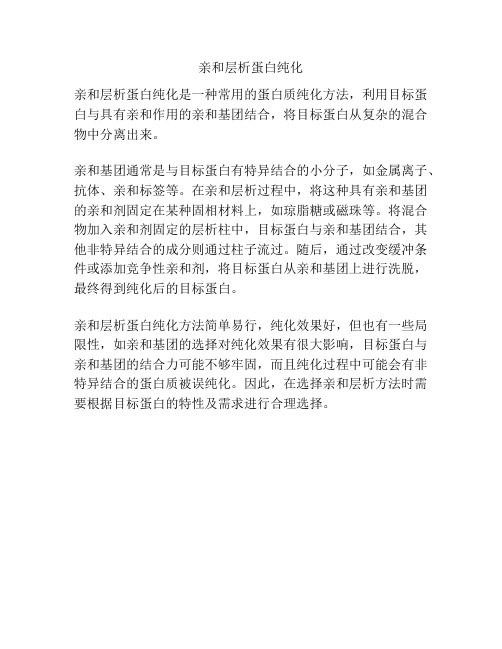
亲和层析蛋白纯化
亲和层析蛋白纯化是一种常用的蛋白质纯化方法,利用目标蛋白与具有亲和作用的亲和基团结合,将目标蛋白从复杂的混合物中分离出来。
亲和基团通常是与目标蛋白有特异结合的小分子,如金属离子、抗体、亲和标签等。
在亲和层析过程中,将这种具有亲和基团的亲和剂固定在某种固相材料上,如琼脂糖或磁珠等。
将混合物加入亲和剂固定的层析柱中,目标蛋白与亲和基团结合,其他非特异结合的成分则通过柱子流过。
随后,通过改变缓冲条件或添加竞争性亲和剂,将目标蛋白从亲和基团上进行洗脱,最终得到纯化后的目标蛋白。
亲和层析蛋白纯化方法简单易行,纯化效果好,但也有一些局限性,如亲和基团的选择对纯化效果有很大影响,目标蛋白与亲和基团的结合力可能不够牢固,而且纯化过程中可能会有非特异结合的蛋白质被误纯化。
因此,在选择亲和层析方法时需要根据目标蛋白的特性及需求进行合理选择。
亲和层析法纯化荧光蛋白
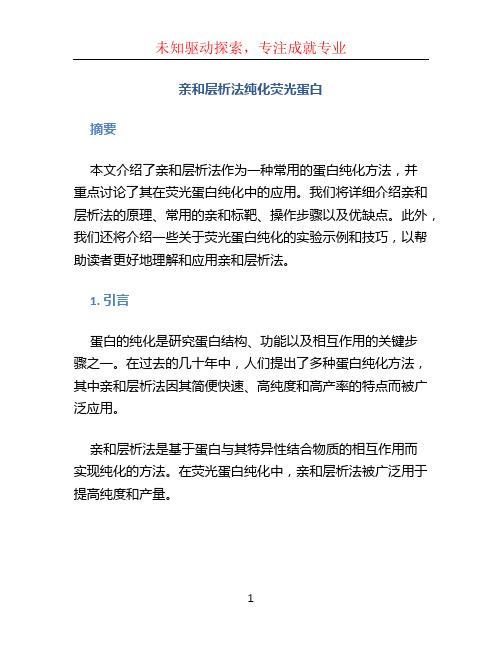
亲和层析法纯化荧光蛋白摘要本文介绍了亲和层析法作为一种常用的蛋白纯化方法,并重点讨论了其在荧光蛋白纯化中的应用。
我们将详细介绍亲和层析法的原理、常用的亲和标靶、操作步骤以及优缺点。
此外,我们还将介绍一些关于荧光蛋白纯化的实验示例和技巧,以帮助读者更好地理解和应用亲和层析法。
1. 引言蛋白的纯化是研究蛋白结构、功能以及相互作用的关键步骤之一。
在过去的几十年中,人们提出了多种蛋白纯化方法,其中亲和层析法因其简便快速、高纯度和高产率的特点而被广泛应用。
亲和层析法是基于蛋白与其特异性结合物质的相互作用而实现纯化的方法。
在荧光蛋白纯化中,亲和层析法被广泛用于提高纯度和产量。
2. 亲和层析法原理亲和层析法的原理基于荧光蛋白与其特异性结合物质(亲和标靶)的相互作用。
亲和标靶可以是化学修饰后的配体、亲和剂或抗体等。
荧光蛋白与其特异性结合物质之间的结合是可逆的,因此可以通过适当的条件将荧光蛋白与亲和标靶分离。
在亲和层析法中,通常会将亲和标靶固定在亲和层析柱上,然后将荧光蛋白溶液通过柱子。
与亲和标靶结合的荧光蛋白会在柱子上保留,而其他的蛋白质则会流出。
随后,通过改变条件,如改变溶液pH值、离子强度或引入竞争性结合剂等,可以实现荧光蛋白与亲和标靶的分离。
3. 常用的亲和标靶在荧光蛋白纯化中,常用的亲和标靶有金属离子、亲和剂和抗体等。
金属离子是一种常见的亲和标靶。
荧光蛋白中常含有结合金属离子的位点,如钙离子、锌离子等。
通过调节溶液中金属离子的浓度或添加竞争性配体,可以实现荧光蛋白与金属离子的结合和分离。
亲和剂是一种特殊的小分子化合物,它们具有与目标蛋白特异性结合的能力。
在荧光蛋白纯化中,亲和剂可以选择与荧光蛋白的特殊结构域或修饰基团结合,实现纯化和分离。
抗体是一种高度特异性的蛋白质,可以与荧光蛋白的特定抗原决定簇结合。
通过将荧光蛋白与特异性抗体结合,可以有效纯化荧光蛋白。
4. 亲和层析法的操作步骤亲和层析法的操作步骤包括亲和标靶固定、样品加载、洗脱和再生等。
分泌蛋白的纯化方法
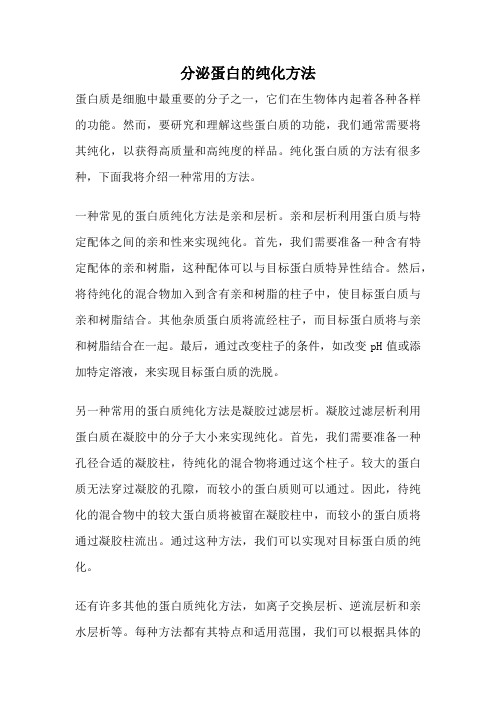
分泌蛋白的纯化方法蛋白质是细胞中最重要的分子之一,它们在生物体内起着各种各样的功能。
然而,要研究和理解这些蛋白质的功能,我们通常需要将其纯化,以获得高质量和高纯度的样品。
纯化蛋白质的方法有很多种,下面我将介绍一种常用的方法。
一种常见的蛋白质纯化方法是亲和层析。
亲和层析利用蛋白质与特定配体之间的亲和性来实现纯化。
首先,我们需要准备一种含有特定配体的亲和树脂,这种配体可以与目标蛋白质特异性结合。
然后,将待纯化的混合物加入到含有亲和树脂的柱子中,使目标蛋白质与亲和树脂结合。
其他杂质蛋白质将流经柱子,而目标蛋白质将与亲和树脂结合在一起。
最后,通过改变柱子的条件,如改变pH值或添加特定溶液,来实现目标蛋白质的洗脱。
另一种常用的蛋白质纯化方法是凝胶过滤层析。
凝胶过滤层析利用蛋白质在凝胶中的分子大小来实现纯化。
首先,我们需要准备一种孔径合适的凝胶柱,待纯化的混合物将通过这个柱子。
较大的蛋白质无法穿过凝胶的孔隙,而较小的蛋白质则可以通过。
因此,待纯化的混合物中的较大蛋白质将被留在凝胶柱中,而较小的蛋白质将通过凝胶柱流出。
通过这种方法,我们可以实现对目标蛋白质的纯化。
还有许多其他的蛋白质纯化方法,如离子交换层析、逆流层析和亲水层析等。
每种方法都有其特点和适用范围,我们可以根据具体的需求选择适合的方法。
蛋白质的纯化是研究和理解蛋白质功能的关键步骤之一。
通过选择合适的纯化方法,我们可以获得高质量和高纯度的蛋白质样品,为后续的研究提供可靠的基础。
希望通过这些纯化方法的应用,我们能够更好地探索蛋白质的奥秘,为人类的健康和科学进步做出更大的贡献。
蛋白纯化的方式
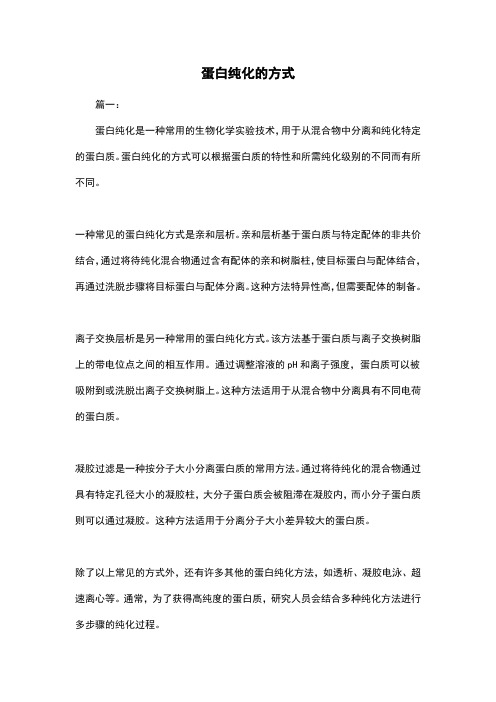
蛋白纯化的方式篇一:蛋白纯化是一种常用的生物化学实验技术,用于从混合物中分离和纯化特定的蛋白质。
蛋白纯化的方式可以根据蛋白质的特性和所需纯化级别的不同而有所不同。
一种常见的蛋白纯化方式是亲和层析。
亲和层析基于蛋白质与特定配体的非共价结合,通过将待纯化混合物通过含有配体的亲和树脂柱,使目标蛋白与配体结合,再通过洗脱步骤将目标蛋白与配体分离。
这种方法特异性高,但需要配体的制备。
离子交换层析是另一种常用的蛋白纯化方式。
该方法基于蛋白质与离子交换树脂上的带电位点之间的相互作用。
通过调整溶液的pH和离子强度,蛋白质可以被吸附到或洗脱出离子交换树脂上。
这种方法适用于从混合物中分离具有不同电荷的蛋白质。
凝胶过滤是一种按分子大小分离蛋白质的常用方法。
通过将待纯化的混合物通过具有特定孔径大小的凝胶柱,大分子蛋白质会被阻滞在凝胶内,而小分子蛋白质则可以通过凝胶。
这种方法适用于分离分子大小差异较大的蛋白质。
除了以上常见的方式外,还有许多其他的蛋白纯化方法,如透析、凝胶电泳、超速离心等。
通常,为了获得高纯度的蛋白质,研究人员会结合多种纯化方法进行多步骤的纯化过程。
总之,蛋白纯化是一项复杂的工作,需要根据目标蛋白质的性质选择合适的纯化方式。
不同的纯化方法可以相互结合,以获得高纯度的蛋白质样品,为后续的实验和研究提供可靠的基础。
篇二:蛋白纯化是生物学和生物化学研究中重要的一步,它可以从混合的蛋白质溶液中分离出目标蛋白质,并去除其他杂质。
蛋白纯化的方式有多种选择,根据目标蛋白质的特性以及实验需求,可以选择不同的方法或结合多种方法来实现纯化。
一种常用的蛋白纯化方法是亲和层析。
亲和层析是利用某种特定的相互作用,例如蛋白质与配体、抗体与抗原之间的特异性结合,将目标蛋白质从混合物中分离出来。
这种方法通常需要在静态或动态的柱上固定具有特异性结合能力的配体或抗体。
目标蛋白质与柱上的配体或抗体结合,并通过洗脱步骤将杂质洗去,最终通过洗脱蛋白质的条件将目标蛋白质从柱上洗脱出来。
蛋白质纯化的方法选择

蛋白质纯化的方法选择随着分子生物学的发展,越来越多的科研人员熟练掌握了分子生物学的各种试验技术,并研制成套试剂盒,使基因克隆表达变得越来越容易;但分子生物学的上游工作往往并非是最终目的,分子克隆与表达的关键是要拿到纯的表达产物,以研究其生物学作用,或者大量生产出可用于疾病治疗的生物制品;相对与上游工作来说,分子克隆的下游工作显得更难,蛋白纯化工作非常复杂,除了要保证纯度外,蛋白产品还必须保持其生物学活性;纯化工艺必须能够每次都能产生相同数量和质量的蛋白,重复性良好;这就要求应用适应性非常强的方法而不是用能得到纯蛋白的最好方法去纯化蛋白;在实验室条件下的好方法却可能在大规模生产应用中失败,因为后者要求规模化,且在每日的应用中要有很好的重复性;本文综述了蛋白质纯化的基本原则和各种蛋白纯化技术的原理、优点及局限性,以期对蛋白纯化的方法选择及整体方案的制定提供一定的指导;1、蛋白纯化的一般原则蛋白纯化要利用不同蛋白间内在的相似性与差异,利用各种蛋白间的相似性来除去非蛋白物质的污染,而利用各蛋白质的差异将目的蛋白从其他蛋白中纯化出来;每种蛋白间的大小、形状、电荷、疏水性、溶解度和生物学活性都会有差异,利用这些差异可将蛋白从混合物如大肠杆菌裂解物中提取出来得到重组蛋白;蛋白的纯化大致分为粗分离阶段和精细纯化阶段二个阶段;粗分离阶段主要将目的蛋白和其他细胞成分如DNA、RNA等分开,由于此时样本体积大、成分杂,要求所用的树脂高容量、高流速,颗粒大、粒径分布宽.并可以迅速将蛋白与污染物分开,防止目的蛋白被降解;精细纯化阶段则需要更高的分辨率,此阶段是要把目的蛋白与那些大小及理化性质接近的蛋白区分开来,要用更小的树脂颗粒以提高分辨率,常用离子交换柱和疏水柱,应用时要综合考虑树脂的选择性和柱效两个因素;选择性树脂与目的蛋白结合的特异性,柱效则是指各蛋白成分逐个从树脂上集中洗脱的能力,洗脱峰越窄,柱效越好;仅有好的选择性,洗脱峰太宽,蛋白照样不能有效分离;2、各种蛋白纯化方法及其优、缺点2.1蛋白沉淀蛋白能溶于水是因为其表面有亲水性氨基酸,在蛋白质的等电点处若溶液的离子强度特别高或者特别低,蛋白则倾向于从溶液中析出;硫酸铵是沉淀蛋白最常用的盐,因为它在冷的缓冲液中溶解性好,冷的缓冲液有利于保持目的蛋白的活性;硫酸铵分馏常用作试验室蛋白纯化的第一步,它可以初步粗提蛋白质,去除非蛋白成分;蛋白质在硫酸铵沉淀中较稳定,可以短期在这种状态下保存中间产物,当前蛋白质纯化多采用这种办法进行粗分离翻;在规模化生产上硫酸铵沉淀方法仍存在一些问题,硫酸铵对不锈钢器具的腐蚀性很强;其他的盐如硫酸钠不存在这种问题,但其纯化效果不如硫酸铵;除了盐析外蛋白还可以用多聚物如PEG和防冻剂沉淀出来,PEG是一种惰性物质,同硫酸铵一样对蛋白有稳定效果,在缓慢搅拌下逐渐提高冷的蛋白溶液中的PEG浓度,蛋白沉淀可通过离心或过滤获得,蛋白可在这种状态下长期保存而不损坏;蛋白沉淀对蛋白纯化来说并不是多么好的方法,因为它只能达到几倍的纯化效果,而我们在达到目的前需要上千倍的纯化;其好处是可以把蛋白从混杂有蛋白酶和其他有害杂质的培养基及细胞裂解物中解脱出来;2.2缓冲液的更换虽然更换缓冲液不能提高蛋白纯度,但它却在蛋白纯化方案中起着极其重要的作用;不同的蛋白纯化方法需要不同pH及不同离子强度的缓冲液;假如你用硫酸铵将蛋白沉淀出来,毫无疑问蛋白是处在高盐环境中,需要想办法脱盐,可用的方法有利用半透膜透析,通过勤换透析液体去除盐分,此法尚可,但需几个小时,通常要过夜,也难以用于大规模纯化中;新型的设备将透析膜夹在两个板中间,板的一侧加缓冲液,另一侧加需脱盐的蛋白溶液,并在蛋白溶液一侧通过泵加压,可以使两侧溶液在数小时内达到平衡,若增加对蛋白溶液的压力,还可迫使水分和盐更多通过透析膜进入透析液达到对蛋白浓缩的目的;也有出售的脱盐柱,柱内的填料是小孔径的颗粒,蛋白分子不能进入孔内,先于高浓度盐离子从柱中流出,从而使二者分离;蛋白纯化的每一步都会造成目的蛋白的丢失,缓冲液平衡的步骤尤甚;蛋白会结合在任何它能接触的表面上,剪切力、起泡沫和离子强度的快速变化很容易让蛋白失活;2.3离子交换色谱这是在所有的蛋白纯化与浓缩方法中最有效方法;基于蛋白与离子交换树脂间的相互电荷作用,通过选择不同的缓冲液,同一种蛋白既可以和阴离子交换树脂能结合带负电荷的分子结合,也可以和阳离子交换树脂结合;树脂所用的带电基团有四种:二乙基氨基乙基用于弱的阴离子交换树脂;羧甲基用于弱的阳离子交换树脂;季铵用于强阴离子交换树脂;甲基磺酸酯用于强阳离子交换树脂;蛋白质由氨基酸组成,氨基酸在不同的pH环境中所带总电荷不同;大多数蛋白在生理pHpH6~8下带负电荷,需用阴离子交换柱纯化,极端的pH下蛋白会变性失活.应尽量避免;由于在某个特定的pH下不同的蛋白所带电荷数不同,与树脂的结合力也不同,随着缓冲液中盐浓度的增加或pH的变化,蛋白按结合力的强弱被依次洗脱;在工业化生产中更多地是改变盐浓度而不是去改变pH值,因为前者更容易控制;在实验室中几乎总是用盐浓度梯度去洗脱离子交换柱,利用泵的辅助可以使流入柱的缓冲液中盐浓度平稳地上升,当离子强度能够中和蛋白的电荷时,蛋白就被从柱上洗脱下来;但在工业生产中盐浓度很难精确控制,所以常用分步洗脱而不足连续升高的盐梯度;与排阻层析相比,离子交换特异性更好,有更多的参数可以调整以获得最优的纯化效果,树脂也比较便宜;值得一提的是,即便是用最精确控制的条件,仅用离子交换单一的方法也得不到纯的蛋白,还需要其他的纯化步骤;2.4亲和层析亲和层析基于目的蛋白与固相化的配基特异结合而滞留,其他杂蛋白会流过柱子;本方法存在的问题是:单抗非常昂贵,而且也需先纯化;单抗与目的蛋白结合力太强.要用苛刻的条件来洗脱,这会使目的蛋白失活并破坏单抗;混合物中的其他蛋白如蛋白酶也可能破坏抗体或与它们非特异结合;某些单抗也会在纯化过程中从树脂上解离下来混入产物中,也需要从终产物中去除;亲和柱通常在纯化过程的后期应用,此时标本体积已缩小,大部分的杂质已经去除;谷胱甘肽S-转移酶GlutathioneS-transferase,GST是最常用的亲和层析纯化标签之一,带有此标签的重组蛋白可用交联谷胱甘肽的层析介质纯化,但本方法有以下缺点:首先,蛋白上的GST必须能合适地折叠,形成与谷胱甘肽结合的空间结构才能用此方法纯化;其次,GST标签多达220个氨基酸,如此大的标签可能会影响表达蛋白的可溶性,使形成包涵体,这会破坏蛋白的天然结构,难于进行结构分析,有时即便纯化后再酶切去除GST标签也不一定能解决问题;另一种可应用的亲和纯化标签是6组氨酸标签,组氨酸的咪唑侧链可亲和结合镍、锌和钴等金属离子,在中性和弱碱性条件下带组氨酸标签的目的蛋白与镍柱结合,在低pH下用咪唑竞争洗脱;组氨酸标签与GST相比有许多优点,首先,由于只有6个氨基酸,分子量很小,一般需要酶切去除:其次,可以在变性条件下纯化蛋白,在高浓度的尿素和胍中仍能保持结合力;另外6组氨酸标签无免疫原性,重组蛋白可直接用来注射动物,也不影响免疫学分析;虽然有这么多的优点,但此标签仍有不足,如目的蛋白易形成包涵体、难以溶解、稳定性差及错误折叠等;镍柱纯化时金属镍离子容易脱落漏出混入蛋白溶液,不但会通过氧化破坏目的蛋白的氨基酸侧链,而且柱子也会非特异吸附蛋白质,影响纯化效果;若目的蛋白可与某种碳水化合物特异结合,或者需要某种特殊的辅因子,可将该碳水化合物或辅因子固相化制成亲和柱,结合后目的蛋白可用高浓度的碳水化合物或辅因子洗脱;2.5疏水作用层析蛋白是由疏水性和亲水性氨基酸组成的;疏水性氨基酸位于蛋白空间结构的中心部位,远离表面的水分子;亲水性氨基酸残基则位于蛋白表面;由于亲水性氨基酸吸引了许多的水分子,所以通常情况下整个蛋白分子被水分子包围着,疏水性氨基酸不会暴露在外;在高盐浓度的环境中蛋白的疏水性区域则会暴露并与疏水性介质表面的疏水性配基结合;不同的蛋白疏水性不同,与疏水作用力大小也不同,通过逐渐降低缓冲液中盐浓度冲洗柱子,在盐浓度很低时,蛋白恢复自然状态,疏水作用力减弱被洗脱出来;疏水性树脂的选择性是由疏水性配基的结构决定的,常用的直链配体为烷基配体alkylligands和芳基配体arylligands,链越长结合蛋白的能力也越强;理想树脂种类的选择应根据目的蛋白的化学性质而定,不能选择结合力太强的树脂,结合力太强的树脂会很难洗脱,所以开始时应选用中等结合力的苯基树脂探讨条件;为了使选择合适的介质更容易,AmershamBiosciences推出了疏水作用树脂选择试剂盒,里面包括5种不同的树脂供比较;疏水层析很适合作为离子交换纯化的下一个步骤,因为疏水作用层析在高盐浓度下上样,从离子交换得到的产物不需更换缓冲液即可使用;蛋白又在低盐缓冲液中洗脱,又省去了下一步纯化前的更换缓冲液的步骤,既节约了时间,又减少了蛋白的丢失;2.6排阻层析也叫凝胶过滤或分子筛;排阻层析柱的填充颗粒是多孔的介质,柱中围绕着颗粒所能容纳的液体量叫流动相,也称无效体积;太大的蛋白不能进入颗粒的孔内,只能存在于无效体积的溶液中,将会最早从柱中洗脱出来,对这部分蛋白无纯化效果;由于各种蛋白的分子大小不同,扩散进入特定大小孔径颗粒内的能力也各异;大的蛋白分子会被先洗脱出来,分子越小,洗脱出来的越晚;为得到最佳的纯化效果,应将孔径大小选在目的蛋白能在无效体积和总柱床体积的中点附近洗脱;排阻层析有其他方法所不具备的优点,首先所能纯化的蛋白分子量范围宽,TosohBiosep公司的聚合物树脂,排阻极限可达200000kD;其次,树脂微孔的形状适合分离球形的蛋白质,纯化过程中也不需要能引起蛋白变性的有机溶剂;应该注意的是某些蛋白不适合用凝胶过滤纯化,因为本技术所用树脂有轻度的亲水性,电荷密度较高的蛋白容易吸附在上面;排阻层析从不用于纯化过程的早期,因为这种方法要求标本高度浓缩,上样量只能在柱体积的1%~4%之间,柱子要细而长才能得到好的分离效果,树脂本身也比较昂贵,规模化的工业生产中不太适用;2.7电泳丙烯酰胺凝胶电泳通常用来查看蛋白混合物样品的复杂程度和监测纯化效果;这种方法分离效果极好,可惜很难在不丧失精度情况下放大到制备规模,因为随着胶厚度的增加,电泳时的热效应会严重干扰蛋白的泳动;在基础研究中,有时仅需要少量的纯蛋白进行研究,如蛋白质测序等,此时电泳纯化不失为一种简便快速的好方法;丙烯酰胺凝胶电泳也是蛋白纯化过程中重要的分析工具,可以检测目的蛋白是在哪个梯度的离子交换柱盐洗脱液中;可用来判定近年来随着各学科的迅猛发展,对蛋白纯化技术的需求不断增长,已有的纯化方法被日益改进,新型的纯化方法也相继涌现;羟磷灰石是磷酸钙的结晶,由于其理化性质不够稳定,结合能力差,很难用于层析;近来Bio-Rad公司对其进行了改进,提高了钙和磷的比例,使形成球形、多孔、性质稳定的陶瓷羟磷灰石颗粒,其带正电的钙离子和负电性的磷酸根离子可分别与蛋白的羧基及氨基结合;通过调整缓冲液的pH值,酸性及碱性氨基酸可选择性地与此树脂结合,改变缓冲液的盐浓度可将蛋白洗脱分离;资料显示,使用这种方法能使两种等电点、分子量和疏水性相同的蛋白很好分离;亲和纯化方面,Sigma发展了利用FLAG标签的纯化方法,FLAG序列为N-AspTyrLysAspAspAspAsp-Lys-C,分子量小且亲水性,与其融合表达的蛋白不易形成包涵体,活性也不受影响,用该公司抗FLAG抗体亲和树脂即可纯化目的蛋白;其他新型标签及相应纯化系统还有CBPCalmodulinBindingPeptide,CBP、Promega公司的BCCPBiofincarboxylcarrierprotein,BCCP标签和亲和素一生物素纯化系统、麦芽糖结合蛋白MaltoseBindingProtein,MBP标签、Biolabs公司的IMPACT-CN系统、Novagen公司的CBD-Tag和,I7-Tag系统等;相信随着时间的推移,会有更多更好的方法出现,合理充分地应用这些方法,对科研、生物制药、疫苗、诊断试剂研制等工作都会有很大帮助蛋白质纯化植物组织蛋白质提取方法summer三氯醋酸—丙酮沉淀法1、在液氮中研磨叶片2、加入样品体积3倍的提取液在-20℃的条件下过夜,然后离心4℃8000rpm以上1小时弃上清;3、加入等体积的冰浴丙酮含0.07%的β-巯基乙醇,摇匀后离心4℃8000rpm以上1小时,然后真空干燥沉淀,备用;4、上样前加入裂解液,室温放置30分钟,使蛋白充分溶于裂解液中,然后离心15℃8000rpm以上1小时或更长时间以没有沉淀为标准,可临时保存在4℃待用;5、用Brandford法定量蛋白,然后可分装放入-80℃备用;药品:提取液:含10%TCA和0.07%的β-巯基乙醇的丙酮裂解液:2.7g尿素0.2gCHAPS溶于3ml灭菌的去离子水中终体积为5ml,使用前再加入1M的DTT65ul/ml;这种方法针对双向电泳,杂质少,离子浓度小的特点当然单向电泳也同样适用,只是电泳的条带会减少11月14日SDS聚丙烯酰胺凝胶电泳测蛋白质分子量SDS聚丙烯酰胺凝胶电泳测蛋白质分子量一、原理蛋白质在聚丙烯酰胺凝胶中电泳时,它的迁移取决于它所带电荷以及分子的大小和形状等因素;在聚丙烯酰胺系统中加入阴离子去污剂十二烷基硫酸钠SDS,大多数蛋白质与SDS按一定比例结合,即每克蛋白质结合1.4克SDS,由于十二烷基硫酸钠根带负电荷,使各种蛋白质的SDS-复合物都带上相同密度的负电荷;它的量大大超过了蛋白质分子原有的电荷量,因而掩盖了不同种类蛋白质原有的电荷差别,使蛋白质分子电泳迁移主要取决于它的分子量,而与所带电荷和形状无关;在一定条件下,蛋白质的分子量与电泳迁移间的关系可用下式表示:lgMW=K-bm式中:MW为蛋白质的分子量,K为常数,b为斜率,m为迁移率因此,若要测定某个蛋白质的分子量,只需比较它和一系列已知分子量的蛋白质在SDS-凝胶电泳时的迁移率就可以了;二、实验试剂1、凝胶贮液丙稀酰胺30%,甲叉双丙酰胺0.8%水溶液;50ml1.5M/LpH8.8Tris-HCl含0.4%SDS4X50ml0.5M/LpH6.8Tris-HCl含0.4%SDS4X50ml10%SDS 50ml10%过硫酸铵10mlTEMED2、溴酚蓝0.25%1ml3、巯基乙醇4、甘油5、样品溶解液2X20ml0.5M/LpH6.8Tris-HCl 5ml10%SDS 8ml巯基乙醇2ml甘油4ml0.25%溴酚蓝1ml6、电极缓冲液5X500mlTris7.57g+ Gly36.03g+ 10%SDS25ml →定容到500mlpH8.37、染色液50mg考马斯亮兰+100ml10%冰乙酸,配制500ml8、脱色液:10%冰乙酸,配制1000ml9、标准分子量液:用0.2mlddw将样品溶解再加0.2ml样品溶解液混匀至EP管中,沸水浴中5分钟10、待测蛋白样品液0.4mg/ml,取0.1ml加0.1ml样品溶解液混匀沸水浴5分钟三、实验方法1、凝胶工作液分离胶配制12ml12T%,27C%Aa30%:Bis0.8%4.8ml双蒸水4.12ml1.5 M/LpH8.8Tris-HCl0.4%SDS4X3.0mlTEMED 0.012ml将以上成分加入一100ml抽滤瓶内,抽气10分钟,灌胶前加入10%的NH42S2O8,0.0675ml,摇匀灌胶;浓缩胶配制6ml4.0T%,2.7C%Aa30%:Bis0.8%0.81ml双蒸水3.65ml0.5M/LpH6.8Tris-HCl0.4%SDS4X1.5mlTEMED 0.009ml使用前加入10%NH42S2O8,0.031ml,摇匀灌胶;2、灌制分离胶本实验采用夹心式垂直平板电泳槽;认真清洗制胶玻璃板,干燥后将两块玻板在电泳槽上装好;用滴管吸取600C左右1%的琼脂糖溶液电极缓冲液配制加热融解封好玻板两侧及下端,待其凝固;插入制孔器,在距制孔器下端1cm处做一标记,取下制孔器将分离胶溶液加入两块玻板之间,至标记处;然后立即用注射器针头向液面轻轻铺上一层厚约0.5cm的双蒸水层注意不要扰乱胶的界面,此时界面逐渐消逝,约30分钟后,由于凝胶聚合,界面又清晰可见,此后在放置30分钟,待凝胶充分聚合后,进行下步操作;3、灌注浓缩胶将分离胶上面的蒸馏水用注射器抽出并用滤纸吸干,将制孔器插入两玻板间,用滴管将浓缩胶液灌入两玻板之间,至玻板顶端;静置电泳槽,待10分钟左右,浓缩胶即可聚合;加入上槽缓冲液至样品槽上端1cm处;4、待测样品的制备取高浓度的待测蛋白,用样品溶解液配成0.2mg/ml,然后在沸水浴上加热5分钟;样品液含盐量应尽可能小,否则必须进行脱盐处理;5、加样和电泳将电泳缓冲液注入缓冲液槽若重复使用分清上下极;上级缓冲液盖过上胶面,然后拔出样品槽板,此时透过电泳槽有机玻璃板壁和电极缓冲液可以清晰地辨认样品槽的位置;将上、下电极与稳流电源的连线接好;用微量遗液器加样,并记录下开始时间及电压值;当样品进入分离胶后,将电流调至10mA处,并记录下开始时间及电压值14:50 42V;当样品进入分离胶后,将电流调至20mA,并记录电压值16:08 110V;电泳约3.5小时,待示踪染料迁移至距凝胶下沿约1.5cm时,记录电流电压值17:45 20mA 160V;然后将电流调回零,关掉电源,取出凝胶板;6、染色和脱色:用取胶片将两张玻板撬开,用玻棒将凝胶直接转入盛有染色液的大培养皿中勿用手触摸凝胶;经常摇动,染色两小时,然后将凝胶转移到脱色液中,换脱色液数次,至背景脱色为止;7、用干胶器将凝胶脱水干燥,便于长期保存;四、分子量计算图1-脱色后凝胶照片图2-标准曲线图五、讨论1、SDS的结合程度如果蛋白质-SDS复合物不能达到1.4克SDS/1克蛋白质的比率并且蛋白质仍具有原来的构象时,就不能得到准确的结果;影响蛋白质和SDS结合的因素主要有:只有在蛋白质分子内的二硫键被彻底还原的情况下,SDS才能定量的结合到蛋白质分子上去并使之具有相同的构象;溶液中的SDS 总量至少要比蛋白质的量高3倍,一般常达十倍以上;溶液的离子强度最高不能超过0.26,在低离子强度的溶液中,SDS单体具有较高的平衡浓度;2、不同的凝胶浓度适用于不同的分子量范围,在5%的凝胶中,分子量25000-200000的蛋白质,其分子量对数与迁移率呈直线关系;在10%的凝胶中,10000-70000分子量的蛋白质,其分子量对数与迁移率呈直线关系;在15%的凝胶中,10000-50000分子量的蛋白质,其分子量对数与迁移率呈直线关系;尽量选择分子量范围和性质与待测样品相近的蛋白质作标准蛋白质;标准蛋白质的相对迁移率最好在0.2~0.8之间均匀分布;3、不是所有的蛋白质都能用SDS-凝胶电泳测定其分子量,因此在分析SDS-凝胶电泳所得结果时,一般至少用两种方法来测定未知样品的分子量,互相验证;。
四种蛋白纯化的有效方法

四种蛋白纯化的有效方法四种蛋白纯化的有效方法在进行蛋白质研究和酶工程等领域的实验过程中,常常需要将目标蛋白从复杂的混合物中纯化出来。
蛋白纯化的目的是获取高纯度的目标蛋白样品,以便进一步进行结构和功能研究。
然而,由于蛋白质的复杂性以及其在混合物中的低浓度,蛋白纯化常常面临一系列的挑战。
为了克服这些挑战,科学家们开发了多种蛋白纯化的方法。
在本文中,我们将介绍四种常见而高效的蛋白纯化方法,并探讨其原理和适用性。
1. 亲和层析法:亲和层析法是一种利用目标蛋白与配体之间的特异性结合进行纯化的方法。
这种方法基于目标蛋白与配体之间的亲和力,通过设计具有高亲和性的配体来选择性地结合目标蛋白。
在实验中,我们可以将配体固定于固相材料上,例如琼脂糖或石蜡烃树脂,并将载有目标蛋白的混合物与这些固定化的亲和基质进行接触。
随后,非特异性蛋白质被洗脱,而目标蛋白则被保留下来。
目标蛋白可以通过改变条件(例如改变pH值或添加竞争性配体)来洗脱。
亲和层析法的优点在于具有高选择性和高纯度的优势。
然而,由于亲和剂的设计和合成需要具有相关专业知识,并且选择适当的配体是关键。
亲和层析法在不同的纯化过程中的适用性会有所不同。
2. 凝胶过滤层析法(Gel Filtration Chromatography):凝胶过滤层析法是通过分子量的差异将混合物中的蛋白质分离的一种方法。
凝胶过滤层析法是利用凝胶材料,例如琼脂糖或琼脂糖-聚丙烯酰胺凝胶,通过分子在凝胶孔隙中的渗透性而将蛋白分离开来。
较大的蛋白分子无法进入凝胶孔隙,因此会在凝胶的表面留下。
较小的蛋白分子则能够渗透进入凝胶孔隙中,因此会相对于较大的蛋白分子更早地溢出。
凝胶过滤层析法的优点在于操作简单、速度快,且可以对蛋白进行某种程度的分离。
然而,该方法的分离效果受到蛋白质在凝胶中的体积效应的限制,因此对于体积较大的蛋白分子,凝胶过滤层析可能无法实现理想的分离效果。
3. 离子交换层析法:离子交换层析法是一种基于蛋白与离子交换材料之间的电荷相互作用进行纯化的方法。
蛋白纯化亲和层析法

蛋白质纯化亲和层析法若表达蛋白质上含有一段六个His 的片段,而亲和吸附胶上接有镍离子,此蛋白质会特异性地结合到吸着胶体;洗去杂质后可imidazole洗脱目标蛋白质。
下面以Abbkine的Resin(树脂填料),Packed Column(预装纯化柱),Kit(试剂盒)产品仪器设备:亲和层析管柱(PurKine™ His-Tag Ni-NTA Packed Column, 1ml*5/3ml*5)部分收集器(另需准备干净试管约25 支)药品试剂:金属螯合亲和层析胶体(PurKine™ His-Tag Ni-NTA Resin) 1 mL◆在交联琼脂糖凝胶上接有nitrilotriacetic acid(NTA)官能基,可以螯合镍离子;使用前先以镍离子饱和的。
Buffer B-300/0(50 mM Na3PO4, pH 8.0; 0.3 M NaCl)◆使用前才添加成10 mM β-mercaptoethanol.Buffer B-300/20: Buffer B-300/0 加有20 mM imidazoleBuffer B-300/250: Buffer B-300/0 加有250 mM imidazole方法步骤:1)亲和层析胶体1 mL 已经装填在管柱内,成为一淡蓝色胶柱。
请把管柱架直在铁架上,去除下方的填塞物,用buffer B-300/0 流洗20 mL 后塞住出口,准备注入样本。
2)除去胶面上方的缓冲液,并取出样本(IEX)使其回到室温,慢慢用滴管加到亲和胶体上,小心勿弄乱胶体表面;让样本没入胶体中,同时收集流出液每管2.5 mL.3)待样本全部进入胶体后,关闭出口,再慢慢加入buffer B-300/20,打开出口收集流出液;buffer B-300/20 共流洗30 mL.4)接着以buffer B-300/250 流洗30 mL,方法同上,收集。
5)所有收集均定量蛋白质并测定酶活性,取收集酶活性最高的数个,保留100 μL 以供分析。
蛋白质的纯化方法
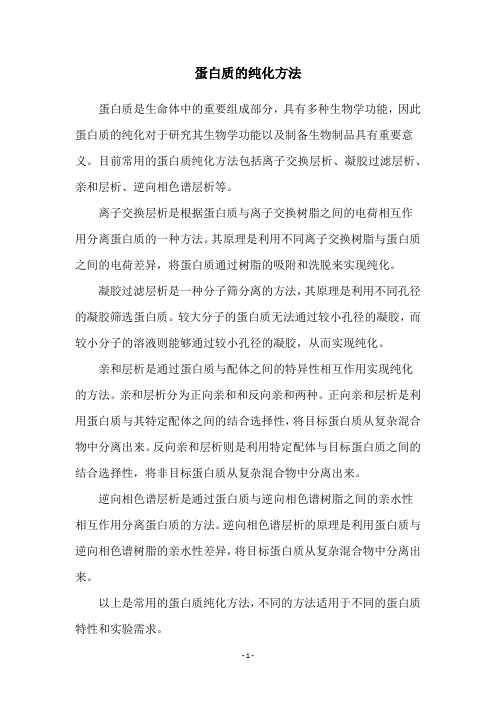
蛋白质的纯化方法
蛋白质是生命体中的重要组成部分,具有多种生物学功能,因此蛋白质的纯化对于研究其生物学功能以及制备生物制品具有重要意义。
目前常用的蛋白质纯化方法包括离子交换层析、凝胶过滤层析、亲和层析、逆向相色谱层析等。
离子交换层析是根据蛋白质与离子交换树脂之间的电荷相互作
用分离蛋白质的一种方法。
其原理是利用不同离子交换树脂与蛋白质之间的电荷差异,将蛋白质通过树脂的吸附和洗脱来实现纯化。
凝胶过滤层析是一种分子筛分离的方法,其原理是利用不同孔径的凝胶筛选蛋白质。
较大分子的蛋白质无法通过较小孔径的凝胶,而较小分子的溶液则能够通过较小孔径的凝胶,从而实现纯化。
亲和层析是通过蛋白质与配体之间的特异性相互作用实现纯化
的方法。
亲和层析分为正向亲和和反向亲和两种。
正向亲和层析是利用蛋白质与其特定配体之间的结合选择性,将目标蛋白质从复杂混合物中分离出来。
反向亲和层析则是利用特定配体与目标蛋白质之间的结合选择性,将非目标蛋白质从复杂混合物中分离出来。
逆向相色谱层析是通过蛋白质与逆向相色谱树脂之间的亲水性
相互作用分离蛋白质的方法。
逆向相色谱层析的原理是利用蛋白质与逆向相色谱树脂的亲水性差异,将目标蛋白质从复杂混合物中分离出来。
以上是常用的蛋白质纯化方法,不同的方法适用于不同的蛋白质特性和实验需求。
亲和层析在蛋白质纯化中的应用.docx

亲和层析在蛋白质纯化中的应用.docx亲和层析在蛋白质纯化中的应用亲和层析(affinity chromatography, AC) 是一种简单易操作的生物大分子分离纯化的重要方法之一,它的基本原理是将与待分离纯化的目标产物具有亲和力的亲和配体固定在载体上(比如说,常用载体有琼脂糖、壳聚糖、纤维素、交联葡聚糖、聚丙烯酰胺、多孔玻璃等),利用目标产物与亲和配体之间的特异性亲和力,使得亲和配体选择性地结合目标产物,从而达到分离纯化的目的。
亲和层析主要包括四个步骤:(1)制备亲和层析柱;(2)样品裂解液与亲和层析柱结合;(3)将杂质洗出;(4)洗脱目标产物。
亲和层析因具有简单易操作、选择性高、载量大以及分离纯化的蛋白纯度较高等优点,因而被广泛应用于在生物大分子的纯化,如结合蛋白、酶、抗体、抗原、DNA、RNA、病毒、细胞等生物大分子的纯化。
本文就亲和层析在近几年蛋白质纯化中的应用作一介绍。
1 亲和层析的类型亲和层析的类型主要有:生物亲和层析(BAFC)、免疫亲和层析(IAFC)、固定化金属离子亲和层析(IMAC)、拟生物亲和层析(BMAFC)以及特殊基团亲和层析等。
科研人员可以根据自己实验的实际需要选择相应的亲和层析方法来达到实验目的。
2 亲和层析在蛋白纯化中的应用蛋白的分离纯化是蛋白组学研究中一个非常重要的环节,蛋白质能否有效的分离纯化关系到整个实验的成败。
2011年Arnold等用有机小分子1A4,2A8,2A9以及2A10作为亲和配体,与N-羟基琥珀酰亚胺活化的琼脂糖凝胶4B(Sepharose 4B)共价结合制备成亲和层析柱,纯化了不同的抗体,其中以2A10作为亲和配体所制得的亲和层析柱纯化得到的抗体产率大于90%,纯度大于80%,这与以蛋白A为配体亲和纯化的抗体的产率和纯度相当,然而小分子为配体的亲和层析柱却解决了以蛋白A为配体易污染、不稳定的难题。
乙酰胆碱酯酶维持乙酰胆碱在动物体内平衡起着非常重要的功能作用,对乙酰胆碱酯酶的研究有着极其深远的意义。
基于亲和层析的两种蛋白质纯化策略共33页文档

1、不要轻言放弃,否则对不起自己。
2、要冒一次险!整个生命就是一场冒险。走得最远的人,常是愿意 去做,并愿意去冒险的人。“稳妥”之船,从未能从岸边走远。-戴尔.卡耐基。
梦 境
3、人生就像一杯没有加糖的咖啡,喝起来是苦涩的,回味起来却有 久久不会退去的余香。
基于亲和层析的两种蛋白质纯化策略 4、守业的最好办法就是不断的发展。 5、当爱不能完美,我宁愿选择无悔,不管来生多么美丽,我不愿失 去今生对你的记忆,我不求天长地久的美景,我只要生生世世的轮 回里有你。
- 1、下载文档前请自行甄别文档内容的完整性,平台不提供额外的编辑、内容补充、找答案等附加服务。
- 2、"仅部分预览"的文档,不可在线预览部分如存在完整性等问题,可反馈申请退款(可完整预览的文档不适用该条件!)。
- 3、如文档侵犯您的权益,请联系客服反馈,我们会尽快为您处理(人工客服工作时间:9:00-18:30)。
1.2.2 Constructions
Fig. 1. Different
strategies to incorporate and remove affinity tags.
1.2.2 Constructions
Con 1
Con1:a linker region including a specific sequence for endoprotease cleavage increase accessibility of the affinity tag and is often required for effective endoprotease cleavage
1.2.2 Constructions
Con 4
Con4:a fusion protein where a solubility and folding partner is fused N-terminal to the target protein (e.g., SUMO, sortase A). An affinity tag at the N-terminus is required for purification. SUMO has emerged as an alternative for the production, solubility and correct folding of otherwise intractable proteins. The SUMO tag can be removed using a specific protease (e.g., the yeast SUMO protease-1 Ulp1) that recognizes the conformation of the ubiquitin partner rather than a specific sequence. The use of SUMO is mostly constrained to E. coli, since highly conserved SUMO proteases are present in eukaryotes.
1.2.1 Common Affinity Tags
6H IMAC (immobilized metal-ion affinity chromatography) Imidazole WSHPQFEK (DYKDDDDK) EDTA
(链亲和素)
SLAELLNAGLGGS and TKDPSRVG
mild condition good for complexes
1.3.1 Proteases
Proteases are enzymes that cleave proteins at specific sequences and are therefore potential candidates to catalyze tag removal. Exopeptidases(aminopeptidases and carboxypeptidases) catalyze the removal of amino acids from the end of a protein and can be used for the removal of very small tags such as His6. Several affinity tagged process endoproteases are therefore used for tag removal such as Thrombin, virus-derived TEV protease, 3C protease , Granzyme B and Caspase-6, used for the removal of His6, GST, FLAG.
1.2.2 Constructions
Con 3
Con3:the simplest genetic design-a fusion protein designed for exopeptidase removal of the tag (only for N-terminal tags, using TAGZyme)
1st step 2nd step
3rd step
The process is designed for the initial purification of the his-tag protein using IMAC; a tag removal step where a protease (or peptidase)—that also contains a his-tag— is added to the his-tag protein and a final subtractive IMAC purification. In this last step, process impurities such as unprocessed his-tag protein, the protease (or peptidase) and any unspecific binder are retained in the column while the detagged ‘pure’ protein is eluted.
1.2.2 Constructions
Con 2
Con2:aid solubility and folding like maltose-binding protein (MBP) , glutathione Stransferase (GST) or small ubiquitin modifying protein (SUMO), thioredoxin (Trx), among others. Some tags such as MBP or GST are used for both affinity purification and solubility. GST binding glutathione-Sepharose resin with the slow binding kinetics is time consuming. MBP can be purified on amylose but may result in protein degradation. His tag both native and denaturing conditions can be used during purification
1.2.2 Benefits
• • • • • (i) improve protein yield (ii) prevent proteolysis (iii) facilitate protein refolding (iv)protect the antigenicity of the fusion protein (v)increase solubility
A general drawback of endoprotease-mediated tag cleavage is the need for high ratios of enzyme to protein and long incubation time required for complete tag removal. An important limitation is that highly specific endopeptidases are typically expensive and unavailable in quantities. In addition, many of these proteases are highly bioactive (e.g. thrombin凝 血酶 and Factor Xa) and must be separated completely from the target protein, often by an additional purification step.
• • • • • • (i) a change in protein conformation (ii)lower protein yields (iii) inhibition of enzyme activity (iv) alteration in biological activity (v)undesired flexibility in structural studies (vi)toxicity
1.3 Tag removal methods
In many scenarios, the presence of a purification tag might alter the activity of the target protein, or cause a therapeutic protein to become immunogenic. Thus, tag removal is a crucial requirement for many of these methods. The following section reviews various tag removal strategies and how improvements in these methods might have an impact on future use.
1 Background 2 Tandem Affinity Tag 3 Self-cleaving purification tags 4 Conclusions and Inspiration
1 Background
1.1
1.2 Affinity Tags
Traditionally, a purification tag has implied use of an affinity separation method. With these methods, the affinity tag is expressed as a fusion partner with the desired target. The tag binds strongly and selectively to an immobilized ligand on a solid support, and cell and process contaminants are washed away. Affinity chromatography typically yields purities >90% in a single column step.
